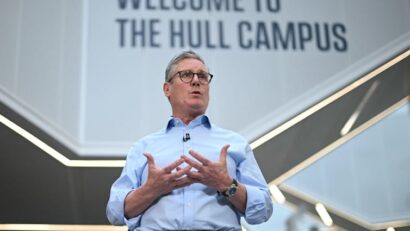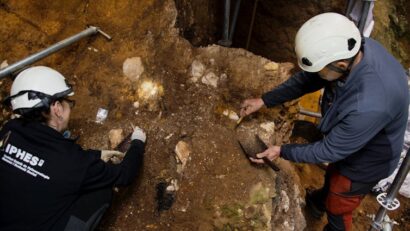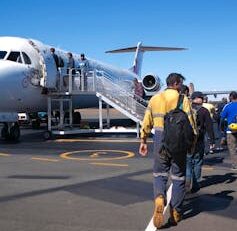While Donald Trump’s special envoy was en route to Moscow to talk about a possible ceasefire deal with his opposite numbers in the Kremlin, Vladimir Putin enjoyed a meet-up with his old friend Alexander Lukashenko, the president of Belarus, and the atmosphere was reportedly congenial.
According to the Guardian’s contemporaneous report, the pair even shared a macabre joke at a press conference after their meeting about Europe being “done for”. Putin hastened to clarify that when Lukashenko said if the US and Russia came to an agreement, Europe would be “done for” he had of course been enjoying a pun. Apparently, said Putin, “pipeline in Russian means also being done for, so this will be to Europe’s benefit, because they will get cheap Russian gas. So they will have a pipeline.”
“That’s what I meant,” said Lukashenko. “Yes, that’s what I thought you did,” Putin replied. Smiles all round from the Russian media audience.
Putin explained that while he’s technically in favour of a ceasefire, there were a few things that needed to be cleared up and that he and Donald Trump would have a phone call to do just that. Top of the list was “removing the root causes of this crisis”, which most observers are translating as Putin maintaining his demand for all four provinces Ukraine that Russian troops currently occupy and an undertaking by Kyiv never to join Nato.
It’s unlikely to meet with the approval of Ukrainian president Volodymyr Zelensky. Zelensky has said he thinks that Putin will do “everything he can to drag out the war” – and Putin’s approach appears to bear this out. This accords with what Stefan Wolff and Tetyana Malyarenko wrote in reaction to the news that the US and Ukraine were at last seeing eye to eye, at least on the need for a halt to the killing.
Sign up to receive our weekly World Affairs Briefing newsletter from The Conversation UK. Every Thursday we’ll bring you expert analysis of the big stories in international relations.
Wolff and Malyarenko, professors of international security at the University of Birmingham and National University Odesa Law Academy respectively, believe Putin will want to keep hostilities going as long as he can while still keeping in with the US president. They see Russia following a “two-pronged approach” – engaging with the White House over the ceasefire proposal while also pushing for further battlefield gains. They write:
The peculiar set-up of the negotiations also plays into the Kremlin’s hands here. Short of direct talks between Kyiv and Moscow, Washington has to shuttle between them, trying to close gaps between their positions with a mixture of diplomacy and pressure. This has worked reasonably well with Ukraine so far, but it is far less certain that this approach will bear similar fruit with Russia.
Read more:
US and Ukraine sign 30-day ceasefire proposal – now the ball is in Putin’s court
In all this shuttle diplomacy, one question that you hear more rarely is what the Ukrainian public will be prepared to accept. Over the past three years Gerard Toal of Virginia Tech University, John O’Loughlin of the University of Colorado and Kristin M. Bakke of UCL have provided us with some valuable insights based on polling of the Ukrainian public. They believe that while the majority of Ukrainians are war-weary and willing to make concessions, even ceding territory in return for peace, they are not willing to compromise their country’s political independence. They also don’t trust Putin and see the war in existential terms.
And, contrary to what Trump might have the world believe, Zelensky remains a popular leader. In fact the latest poll finds his support up ten points on the previous survey at 67%. (Incidentally, Trump posted on his TruthSocial website recently that Zelensky’s approval rating was 4%.) They conclude:
It will be in large part down to ordinary Ukrainians to shape what happens afterwards. An ugly peace may be accepted by a war-weary population. But if it has little local legitimacy and acceptance, peace is likely to be unsustainable in the long run.
Read more:
Are Ukrainians ready for ceasefire and concessions? Here’s what the polls say
Russia, meanwhile, has weathered the conflict remarkably well, certainly better than the analysts who forecast in the summer of 2022. It that stage, when Ukraine’s counter-offensive was pushing the invaders out of occupied territory, inflicting major casualties and destroying huge amounts of equipment, some observers thought that Russia’s economy would collapse under the weight of defeat and western sanctions.
Not so, writes Alexander Hill of the University of Calgary. Hill, a military historian, observes the ways in which the Russian war machine has adapted to conditions over the past two years, ditching the recklessness which saw it suffer such grievous losses in 2022 and using more conservative tactics coupled with smart adoption of new technology to give it an edge on the battlefield. He concludes: “While the Russian army remains a relatively blunt instrument, it is not as blunt as it was in late 2022 and early 2023.”
Read more:
Why Russia’s armed forces have proven resilient in the war in Ukraine
Turning off US aid
Of course, when the US suspended its intelligence-sharing for a few days last week it was a major boost for the Russians. Without data from US satellite coverage and other intelligence traffic, Ukraine’s defenders were left virtually deaf and blind at a crucial time. It gave Russia the space to push its advantage even further as it races to take more territory ahead of a possible peace deal.
The state of the conflict in Ukraine, March 10 2025.
Institute for the Study of War
It’s a bitter lesson for Ukraine to have to learn at this stage in the conflict, write Dafydd Townley and Matthew Powell, experts in international security and strategy at the University of Portsmouth. They believe relying too heavily on one ally for so much was never going to be a good idea and has been exposed as risky since Donald Trump returned to the White House. Perhaps even more risky, given the personality involved, is Ukraine’s dependence on data from ELon Musk’s Starlink satellite system. Musk himself has boasted that: “My Starlink system is the backbone of the Ukrainian army. Their entire front line would collapse if I turned it off.”
Egotistical self-promotion aside, Musk is probably right about this, but less so when he says there’s no alternative. Townley and Powell believe that it’s in Ukraine’s best interests to look into other satellite systems available to them and note that shares in French-owned satellite company Eutelsat, a European rival to Starlink have recently climbed by almost 400%.
Read more:
The US has lifted its intelligence sharing pause with Ukraine. But the damage may already be done
Many of us who are watching this conflict closely cringed when Trump announced he would cut off military assistance to Ukraine after his (one-sided, it has to be said) shouting match with Volodymyr Zelensky at the end of February. And the announcement that the Pentagon was halting intelligence-sharing as noted above simply made matters worse.
It felt like a spiteful move. Psychologist Simon McCarthy-Jones of Trinity College, Dublin, has written a book about spite which delves into, among other things, exhibitions of spitefulness in the public arena. It’s a fascinating read. A spiteful approach to foreign policy, he writes, is when we abandon what he calls “humanity’s superpower” – cooperation.
Trump’s approach, as exemplified by his treatment of Zelensky and also by his baffling decision to impose tariffs even on his friends and allies, “embraces selfishness, treating international relations as a zero-sum game where there can only be one winner”.
Read more:
Donald Trump’s foreign policy might be driven by simple spite – here’s what to do about it
One of the sticking points between the US and Ukraine has been the question of security guarantees in case of a ceasefire or even a longer-term peace deal. It seems increasingly far-fetched that Ukraine will be allowed to join Nato any time soon, so Nato article 5 protections, which would mean that all other member states would be obliged to come to its defence, will not be an issue.
Trump’s vice-president, J.D. Vance, has suggested that if Ukraine allows US companies access to its mineral resources this would in itself be a security guarantee feels equally improbable. And, in any case, how valuable have US security guarantees been in the past, asks historian Ian Horwood, of York St John University. Horwood pints to the Paris Peace accords of 1973 in which the Nixon administration promised to underwrite South Vietnam’s continued security, while withdrawing US combat troops. Within two years, North Vietnamese tanks were rolling into Saigon.
More recently the Doha agreement between the first Trump administration and the Taliban was made without involving the Afghan government and didn’t even last long enough for US and Nato troops to get out of Kabul. This sorry history will no doubt have given Zelensky food for thought.
Read more:
What is the value of US security guarantees? Here’s what history shows
Ukraine’s mineral wealth
All the while many of us have been asking what’s so special about Ukraine’s minerals. We’ve long known about the country as the “bread basket of Europe”, but what is not as widely understood is Ukraine’s mineral wealth. Geologist Munira Raji of the University of Plymouth, says Ukraine has deposits containing 22 of 34 critical minerals identified by the European Union as essential for energy security. This, she says, positions Ukraine among the world’s most resource-rich nations.
Where Ukraine’s minerals are and how much is in areas occupied by Russia.
Conflict and Environment Observatory: www.ceobs.org
Much of this cornucopia of geological booty is contained in what is known as the “Ukrainian shield” which sits underneath much of the country, writes Raji. Here she walks us through the riches beneath Ukraine’s soil and why America is so keen to get its hands on them.
Read more:
What’s so special about Ukraine’s minerals? A geologist explains
World Affairs Briefing from The Conversation UK is available as a weekly email newsletter. Click here to get updates directly in your inbox. Läs mer…








